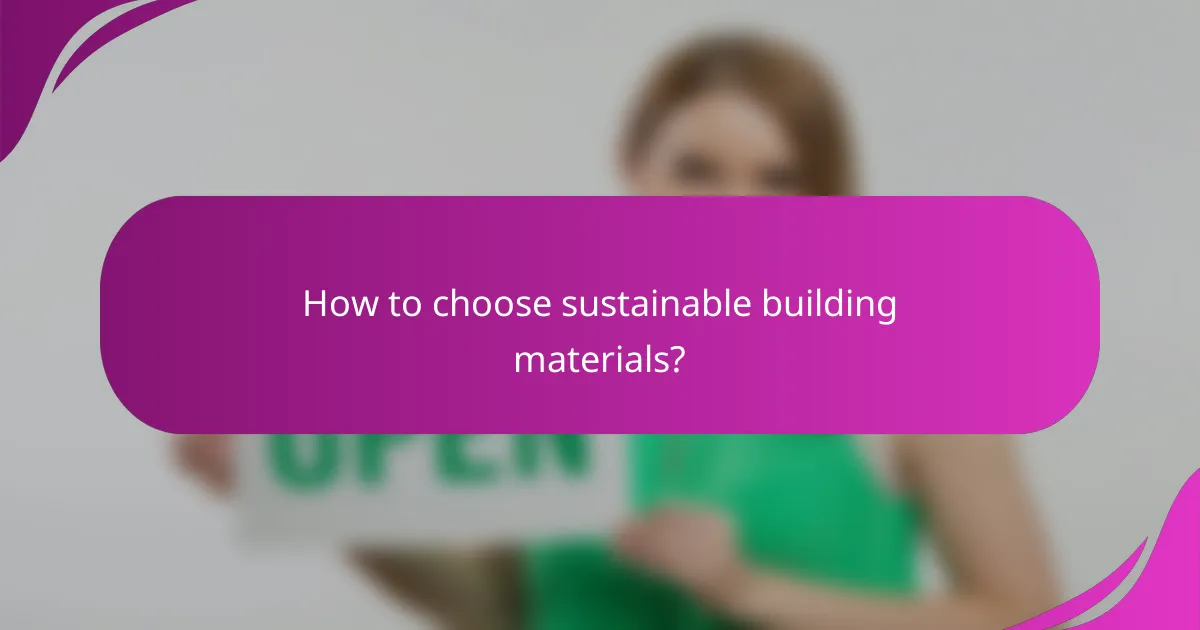Sustainable building practices are essential for creating structures that minimize environmental impact while promoting energy efficiency and resource conservation. By utilizing responsibly sourced materials, implementing advanced technologies, and adhering to thoughtful design principles, these practices contribute to healthier living environments and reduced utility costs. Emphasizing sustainability in construction not only benefits the planet but also enhances the quality of life for its inhabitants.

What are sustainable building materials?
Sustainable building materials are those that have a minimal environmental impact, are sourced responsibly, and can be reused or recycled. These materials contribute to energy efficiency, reduce waste, and promote healthier living environments.
Bamboo as a renewable resource
Bamboo is a highly renewable resource due to its rapid growth rate, often reaching maturity in just three to five years. Its strength and flexibility make it an excellent choice for various construction applications, including flooring and structural supports.
When using bamboo, consider sourcing it from certified plantations to ensure sustainable harvesting practices. This helps maintain biodiversity and reduces deforestation pressures.
Recycled steel for structural integrity
Recycled steel is a durable and strong material that can significantly reduce the carbon footprint of a building project. Using recycled steel can lower energy consumption during production by up to 75% compared to new steel.
When selecting recycled steel, look for materials that meet industry standards such as those set by the American Institute of Steel Construction (AISC). This ensures the structural integrity and safety of your building.
Hempcrete for insulation
Hempcrete is a biocomposite material made from hemp hurds and lime, providing excellent insulation properties while being lightweight and breathable. It helps regulate indoor humidity and can improve overall energy efficiency.
When using hempcrete, ensure it is properly mixed and applied to maximize its insulating benefits. It is not load-bearing, so it should be used in conjunction with a structural framework.
Low-VOC paints for air quality
Low-VOC (volatile organic compounds) paints are designed to minimize harmful emissions, improving indoor air quality. These paints are essential for creating healthier living spaces, especially in tightly sealed buildings.
When choosing low-VOC paints, check for certifications such as Green Seal or the EPA’s Safer Choice label. This ensures that the products meet strict environmental and health standards.

How can energy efficiency be improved in buildings?
Energy efficiency in buildings can be enhanced through various strategies, including the use of advanced materials, technologies, and design principles. Implementing energy-efficient solutions not only reduces utility bills but also minimizes environmental impact.
Energy-efficient windows and doors
Energy-efficient windows and doors are designed to minimize heat loss and gain, significantly improving a building’s overall energy performance. Look for products with low U-values and high Solar Heat Gain Coefficient (SHGC) ratings, which indicate better insulation and solar control.
Consider double or triple glazing with argon gas fills, as these options can reduce energy consumption by up to 30% compared to standard single-pane windows. Proper installation is crucial; ensure that frames are sealed tightly to prevent air leaks.
Insulation materials for temperature control
Choosing the right insulation materials is vital for maintaining comfortable indoor temperatures and improving energy efficiency. Common options include fiberglass, foam board, and spray foam, each offering different R-values, which measure thermal resistance.
For optimal performance, aim for insulation levels that meet or exceed local building codes. In colder climates, higher R-values are necessary, while milder areas may require less insulation. Pay attention to areas like attics and basements, where heat loss is often significant.
Smart thermostats for energy management
Smart thermostats enhance energy efficiency by allowing for precise temperature control and scheduling based on occupancy patterns. These devices can learn user habits and adjust settings automatically, leading to energy savings of around 10-15% on heating and cooling costs.
When selecting a smart thermostat, ensure compatibility with your HVAC system and consider features such as remote access, energy usage reports, and integration with other smart home devices. Regularly review and adjust settings to maximize energy savings throughout the year.

What design principles promote sustainability?
Design principles that promote sustainability focus on minimizing environmental impact while maximizing resource efficiency. Key strategies include using renewable materials, optimizing energy use, and enhancing the natural environment through thoughtful design.
Passive solar design techniques
Passive solar design techniques harness sunlight for heating and cooling without mechanical systems. This can involve orienting buildings to maximize sun exposure, using thermal mass materials to store heat, and incorporating overhangs to block excessive summer sun.
Consider using large south-facing windows for light and warmth, while ensuring proper insulation to maintain temperature. In temperate climates, this can reduce heating costs by a significant margin, often by 30% or more during winter months.
Green roofs for biodiversity
Green roofs are an effective way to enhance biodiversity in urban areas. By planting vegetation on rooftops, they provide habitats for various species, improve air quality, and reduce stormwater runoff.
When designing a green roof, select native plants that require less maintenance and water. This can lead to lower irrigation costs and support local wildlife, creating a thriving ecosystem in an otherwise barren environment.
Open floor plans for natural light
Open floor plans promote natural light penetration, which can enhance the overall ambiance and reduce reliance on artificial lighting. By minimizing walls and barriers, spaces can feel larger and more inviting.
To maximize natural light, consider using large windows or skylights. This approach not only improves energy efficiency but also contributes to occupants’ well-being by creating a more pleasant living environment. Aim for at least 10% of the floor area to be window space to achieve optimal light levels.

What are the benefits of sustainable building practices?
Sustainable building practices offer numerous benefits, including cost savings, enhanced health for occupants, and increased property values. By utilizing eco-friendly materials and energy-efficient designs, these practices contribute to a healthier environment and lower long-term expenses.
Reduced energy costs
One of the primary advantages of sustainable building practices is the significant reduction in energy costs. Implementing energy-efficient systems, such as LED lighting, high-efficiency HVAC systems, and proper insulation, can lower utility bills by a substantial margin, often by 20-50% compared to conventional buildings.
In addition, renewable energy sources like solar panels can further decrease reliance on grid electricity, leading to long-term savings. Homeowners and businesses should consider local incentives or rebates for energy-efficient upgrades to maximize financial benefits.
Improved occupant health
Sustainable building practices enhance occupant health by promoting better indoor air quality and reducing exposure to harmful materials. Using non-toxic paints, sustainable flooring, and proper ventilation systems can minimize allergens and pollutants, leading to healthier living and working environments.
Research indicates that buildings designed with sustainability in mind can significantly reduce respiratory issues and other health problems among occupants. Incorporating natural light and green spaces can also improve mental well-being, making these practices beneficial for both physical and psychological health.
Increased property value
Properties built or renovated with sustainable practices often see an increase in market value. Buyers are increasingly prioritizing energy efficiency and eco-friendly features, which can lead to higher resale prices. Studies suggest that homes with green certifications can sell for up to 10% more than traditional homes.
Investing in sustainable materials and technologies not only enhances the appeal of a property but also ensures compliance with evolving building regulations. As sustainability becomes a standard expectation, properties that incorporate these practices are likely to retain their value better over time.

What regulations affect sustainable building in the US?
Sustainable building in the US is influenced by various regulations that promote energy efficiency, environmental protection, and resource conservation. Key regulations include LEED certification requirements, Energy Star standards, and local building codes, particularly in states like California.
LEED certification requirements
LEED (Leadership in Energy and Environmental Design) certification is a widely recognized standard for sustainable building. To achieve LEED certification, projects must meet specific criteria across several categories, including energy efficiency, water usage, indoor environmental quality, and sustainable site development.
There are different levels of certification: Certified, Silver, Gold, and Platinum, each requiring a certain number of points based on the project’s performance. For instance, a project aiming for Gold certification typically needs to score between 60 and 79 points.
Energy Star standards
Energy Star is a program that helps businesses and individuals save money and protect the environment through energy-efficient products and practices. Buildings that meet Energy Star standards are at least 10% more energy-efficient than typical buildings, with many achieving much higher savings.
To qualify, a building must undergo a comprehensive energy assessment and demonstrate improved energy performance. This can include upgrades to HVAC systems, insulation, and lighting, which collectively contribute to reduced energy consumption and lower utility bills.
Local building codes in California
California has some of the most stringent building codes in the US, particularly regarding energy efficiency and sustainability. The California Energy Code (Title 24) mandates specific energy-saving measures for new construction and major renovations, including high-performance insulation and efficient HVAC systems.
Additionally, California encourages the use of renewable energy sources, such as solar panels, through incentives and requirements in certain areas. Builders must stay updated on local amendments to ensure compliance with evolving regulations aimed at reducing greenhouse gas emissions and promoting sustainable practices.

How to choose sustainable building materials?
Choosing sustainable building materials involves selecting options that minimize environmental impact while maximizing durability and efficiency. Key factors include sourcing, lifecycle impacts, and energy efficiency.
Assessing lifecycle impacts
Assessing lifecycle impacts means evaluating the environmental effects of materials from extraction to disposal. This includes considering energy use, emissions, and resource depletion at each stage of a material’s life.
To effectively assess lifecycle impacts, utilize tools like Life Cycle Assessment (LCA) which can provide insights into the total environmental footprint. Focus on materials that are renewable, recyclable, or have a low carbon footprint, such as bamboo or recycled steel.
When selecting materials, consider local regulations and certifications, such as LEED or BREEAM, which can guide you toward more sustainable choices. Aim for materials that not only meet your design needs but also contribute positively to the environment over their entire lifecycle.


